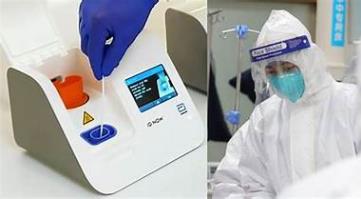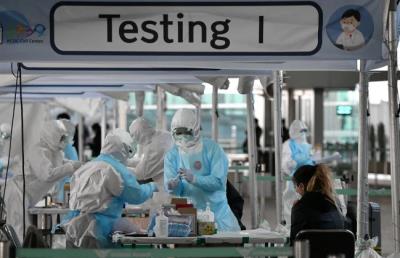|
It is axiomatic that decisions relating to operation of plants in the current COVID-19 era and assessing the effectiveness of preventive measures should be based on real-time evaluation of the incidence rate of the infection. By definition incidence is the number of new cases in a population identified within a specific time period.
Questions have arisen as to the sensitivity and specificity of the Abbott ID NOW® system approved by the FDA under an emergency use authorization. The kit relies on immuno-based technology to detect nucleic acids from SARS-CoV-2 virus responsible for COVID-19. The intended use of the Abbott ID Now® assay is to rapidly screen large numbers of individuals either in the community or working in plants for the presence of virus in their upper respiratory tract. Effective suppression of COVID-19 requires that infected individuals should be quarantined, and contacts should be traced.
|

ABBOTT ID-NOW |
During the first few months of the COVID-19 outbreak, antigen tests were in short supply. Healthcare providers restricted their use to those presenting with symptoms consistent with the infection especially in patients not demonstrating positive influenza assays. With the realization that  asymptomatic carriers are responsible for dissemination of virus, possibly with an R0 of 2 or more, infections can spread quickly when susceptible individuals are in close proximity to either symptomatic or asymptomatic carriers. The “super spreader” situation is evidenced by cruise ships, mass gathering, nursing homes, prisons and more recently in packing plants where infection rates of 25 to 50 percent have been recorded.
asymptomatic carriers are responsible for dissemination of virus, possibly with an R0 of 2 or more, infections can spread quickly when susceptible individuals are in close proximity to either symptomatic or asymptomatic carriers. The “super spreader” situation is evidenced by cruise ships, mass gathering, nursing homes, prisons and more recently in packing plants where infection rates of 25 to 50 percent have been recorded.
Any diagnostic test has two major characteristics that define whether it is suitable for a given application:-
- Sensitivity is the ability to detect the pathogen of interest
Test with low sensitivity provide false negative results. Test with high sensitivity should detect most if not all infected individuals.
- Specificity is the ability of a test to distinguish between related pathogens.
A test with low specificity may not be able to distinguish between the SARS-CoV-2 virus and an unrelated coronavirus such as that causing the common cold. Assays procedures with low specificity will yield a high number of false positives. In contrast high specificity presumes that the test can successfully identify the pathogen of interest to the exclusion of related or even unrelated disease-causing organisms.
Abbott has indicated that under controlled testing conditions the ID Now® test kit correctly identified 30 out of 30 viral samples indicating 100 percent sensitivity. The test identified as negative, 30 out of 30 known negative samples confirming 100 percent specificity. Generally, a test is inclined either to sensitivity or specificity and only very rarely is it both highly sensitive and specific.
In contrast to the data generated by Abbott, a study on one hundred patients at New York University, Langone-Trisch Hospital determined that in practice the tests demonstrated low sensitivity generating an unacceptable level of false negative results. Similar lack of sensitivity was recorded in other centers using the Abbott procedure, which has the decided advantage of providing a diagnosis within five to twenty-minutes.
The Abbott assay is used extensively in screening programs despite numerous respected health care organizations abandoning deployment. Both CVS and Walgreens are however using the test for mass screening and in some cases, hospitals are verifying negative results in patients with clinical symptoms using more specific secondary assays including the Abbott RealTIME® rt-PCR assay that detects RdRp and N-genes.
Patient literature provided with the Abbott tests note "that in the event of a positive test result it is very likely that you have COVID-19. The literature also states that a negative test means that the virus that causes COVID-19 was not found in the sample". Abbot acknowledges the possibility of false negatives in the statement "this means that you could possibly still have COVID-19 even though the test is negative".
Extensive deployment of the Abbott test may be underestimating the true prevalence of COVID-19 in specific populations. This is important when making decisions as to whether plants should be closed and whether preventive procedures should be intensified. Perhaps the highest-visibility application of the test is in the White House. Although two Administration officials have been diagnosed with COVID-19, there have been questions as to why positive and negative results were obtained on consecutive days. Evidently even with the most meticulous and professional sampling of individuals, the test will generate inconsistent results. The Abbott test has the advantages of speed, compactness with respect to equipment and is deployable at any site obviating the need to submit specimens to a remote diagnostic laboratory.
Accepting the low sensitivity of the test, it has an important role to play in screening among confined populations such as in prisons, nursing homes and packing plants. Obviously, clinicians in hospitals must be guided by clinical presentation in patients and submit questionable results to their diagnostic laboratories for validation using more sensitive and specific PCR assays to accurately determine a diagnosis to guide in the selection of treatment options.